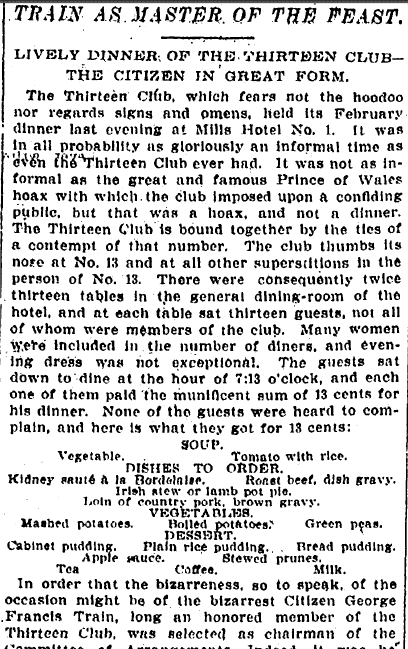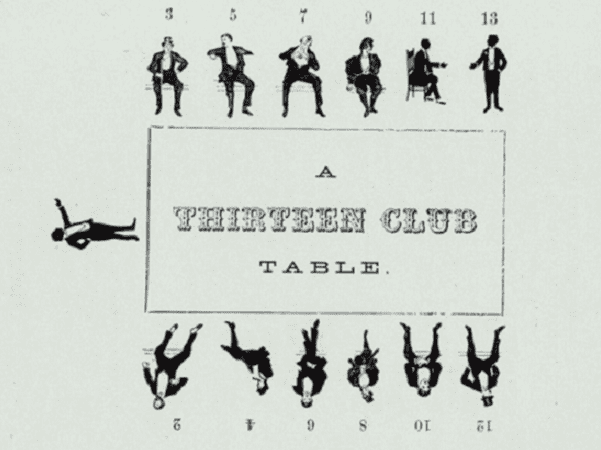Introduction: In this article—appropriate for Friday the 13th—Gena Philibert-Ortega searches old newspapers to find stories about Captain William Fowler and the Thirteen Club he founded in 1880 to defy superstitions about the number 13. Gena is a genealogist and author of the book “From the Family Kitchen.”
Superstitions about 13
There are four Fridays in September and one of those—today—is a day that some look upon with dread. September marks the first of two occurrences of Friday the 13th in 2013; the other happens in December. While popular horror movies have been made about this day, it’s not just Friday the 13th that scares some people—it’s also the bad luck associated with the number 13 in general.
Many superstitions have existed around that number, whether it’s about a room numbered 13 or the 13th floor. All kinds of cautions exist including numerous warnings about sitting 13 people at a table. One such superstition declares that whenever 13 sit at a table, one will die within the year. Triskaidekaphobia, the fear of the number 13, was something well known to our 19th century ancestors.
History of the Thirteen Club
Because of these numerous superstitions around the number 13, in 1880 a Captain William Fowler decided to test some of those superstitions and prove them false by creating a social club known as the Thirteen Club in New York. He tested the fates by decreeing that his club would meet on the thirteenth day of the month and he would have 13 people sit at a dining table in room 13. Other superstitions he incorporated included having guests walk under a ladder and breaking a mirror.
His club was a way to show that superstitions were “a relic of the past that impeded progress.”* Should none of his 13 members die during the year after the meeting, he would show that the superstition around the number 13 was unfounded. Although his club was organized in 1880 it took a year to find 13 members brave enough to join.**
We get a sense of what a meeting of the Thirteen Club might have entailed from old newspapers. This article from an 1898 New York newspaper provided the menu for a meeting, related some of what occurred, and gave a few names of those in attendance.

Those original 13 members of the New York Thirteen Club grew to 487 members by 1887. Soon other Thirteen Clubs started around the United States, both official and unofficial clubs.*** This article from an 1885 Missouri newspaper recounted a Thirteen Club meeting in Chicago.
While the Thirteen Club began as an all-male club, they eventually decided that they needed to encourage female participation because women were “the more superstitious sex.” Special dinners were held where women were invited, and women spoke on the superstitions that kept them subjugated—including the need for suffrage. Eventually, separate Thirteen Clubs for women were also formed.****
This historical newspaper article from an 1894 New York newspaper reported on one of the Annual Ladies’ Dinners including the fact that a mirror broke, and pieces from it were given out as souvenirs of the night. The women in attendance were listed at the conclusion of the article.
It appears that Thirteen Clubs died out in the early 1920s. Today, there are various mentions online of similar revival clubs meeting in an attempt to thumb their collective nose at superstitions.
* The Story of the World’s Most Popular Superstition by Nathaniel Lachenmeyer. New York: Thunder’s Mouth Press. 2004. Page 3.
** Ibid.
***Ibid, page 7.
****Ibid, page 10.
